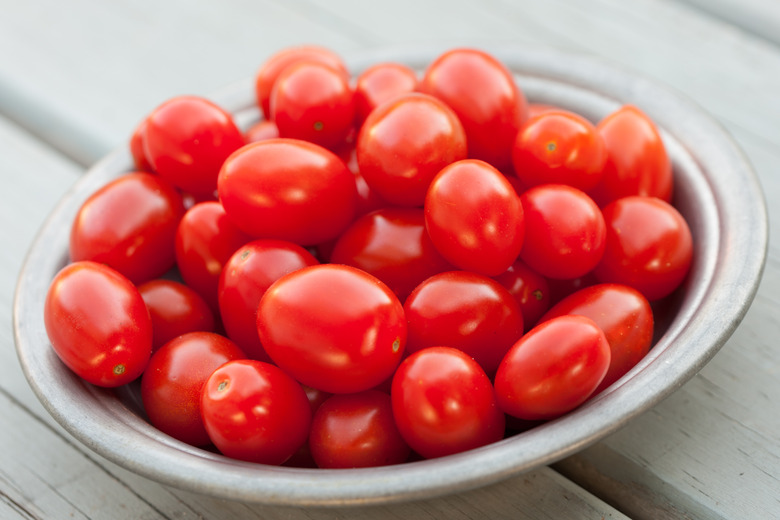How To Grow Grape Tomatoes In A Pot
We may receive a commission on purchases made from links.
Growing grape tomatoes (Lycopersicon esculentum, USDA zones 10-11) in a pot is a good alternative when you don't have space for a vegetable garden. A container vegetable garden on a sunny porch or patio lets you enjoy homegrown grape tomatoes easily. It's relatively easy to enjoy a bountiful harvest from just a few potted plants, if you give them just a bit of special attention to keep the harvest coming.
Getting Grape Tomato Plants Started
Getting Grape Tomato Plants Started
A grape tomato is a small cherry tomato that's about 1 inch in diameter, the approximate size and shape of a grape. An especially prolific type of tomato, a single plant produces many dozens of fruits when given good growing conditions.
Before you grow grape tomatoes in a pot, start seeds in seed starter trays or pots indoors about six weeks before your last frost date, or purchase seedlings from a nursery center when ready to plant. Either way, harden off seedlings by moving them outdoors for a few extra hours each day, planting them when nighttime temperatures stay above 45 degrees Fahrenheit.
When ready, choose a pot that's at least 20 inches across and 24 inches deep, with one plant for each pot. The pot must have at least one large drainage hole and can be plastic, which tends to dry out slowly, or clay, a more quickly drying material.
Soil, Sun and Water
Soil, Sun and Water
When you grow grape tomatoes in a pot, you need loose, well-drained soil that's rich in organic matter. You can use a high-quality commercial mix, or make your own from equal parts potting soil, compost, sphagnum peat moss and perlite. Avoid using garden soil because it likely harbors insect pests or their eggs, and it will quickly become compacted in a container, which impedes root growth.
Plant one seedling in each pot, setting it deeply so that the soil level is just below the first set of leaves. This stimulates roots to grow from the buried stem, promoting a strong plant.
Keep the pot in full sun for at least six to eight hours of sun daily. If your area has hot summer afternoons, choose a spot that gets sun mostly in the morning. Give the plant regular watering, moistening the soil thoroughly whenever its top inch or two feels dry to your fingertip. Aim for at least 1 inch of water each week, including rain.
Supporting and Feeding
Supporting and Feeding
Some grape tomatoes, such as Mighty Sweet, are determinate, reaching a maximum height in midseason. This type becomes naturally bushy and may not need support in its pot.
Indeterminate varieties get taller all season long and need support in their pot. Red Pearl is an example of this type. Use a commercially available tomato cage or a sturdy stake to support this plant, but place the support in the pot before planting, to prevent damaging the plant's roots. Tie the plant to the support at intervals, using soft ties.
Fertilize the plant regularly. The first grape tomatoes are usually ready to harvest about 75 days after planting, so start fertilizing plants once weekly when you see the first small, green fruits, usually sometime in July, depending on your climate. Use a balanced, 20-20-20 formula, applied at the rate and dilution proportions indicated on the label. Wet the soil before applying fertilizer to avoid burning roots.
Possible Grape Tomato Problems
Possible Grape Tomato Problems
When you grow grape tomatoes in a pot, they are susceptible to several fungal disorders just like they would be in a garden. These are best prevented by keeping the pot in a well-ventilated area that's not crowded by other plants and by watering the plant at its base early in the day, helping keep foliage dry.
Several pests can also cause problems, including the green tomato hornworm caterpillar and the brown, striped potato beetle. Handpick and destroy these. Aphids, tiny, yellowish, soft-bodied insects, and small whiteflies can also feed on and weaken the plant. Control these by spraying them off plants with a stream of water. Use insecticidal soap with caution because some tomato cultivars are sensitive to soaps and can be damaged by their use.
